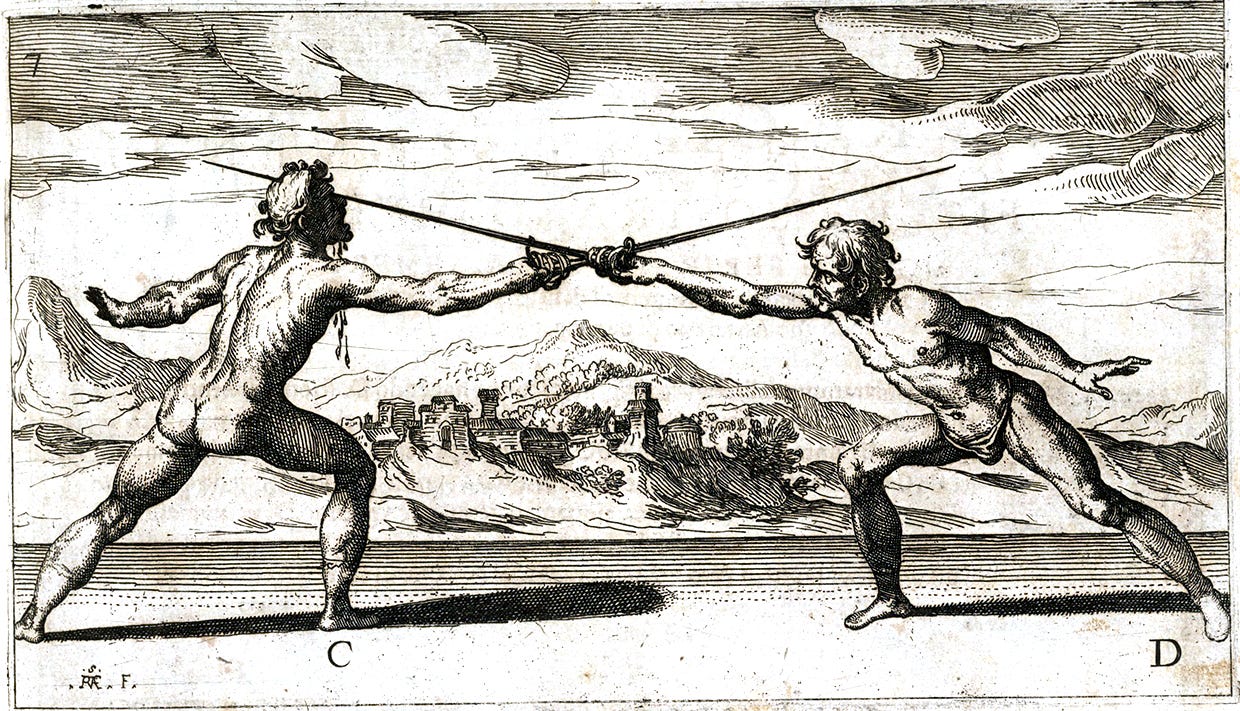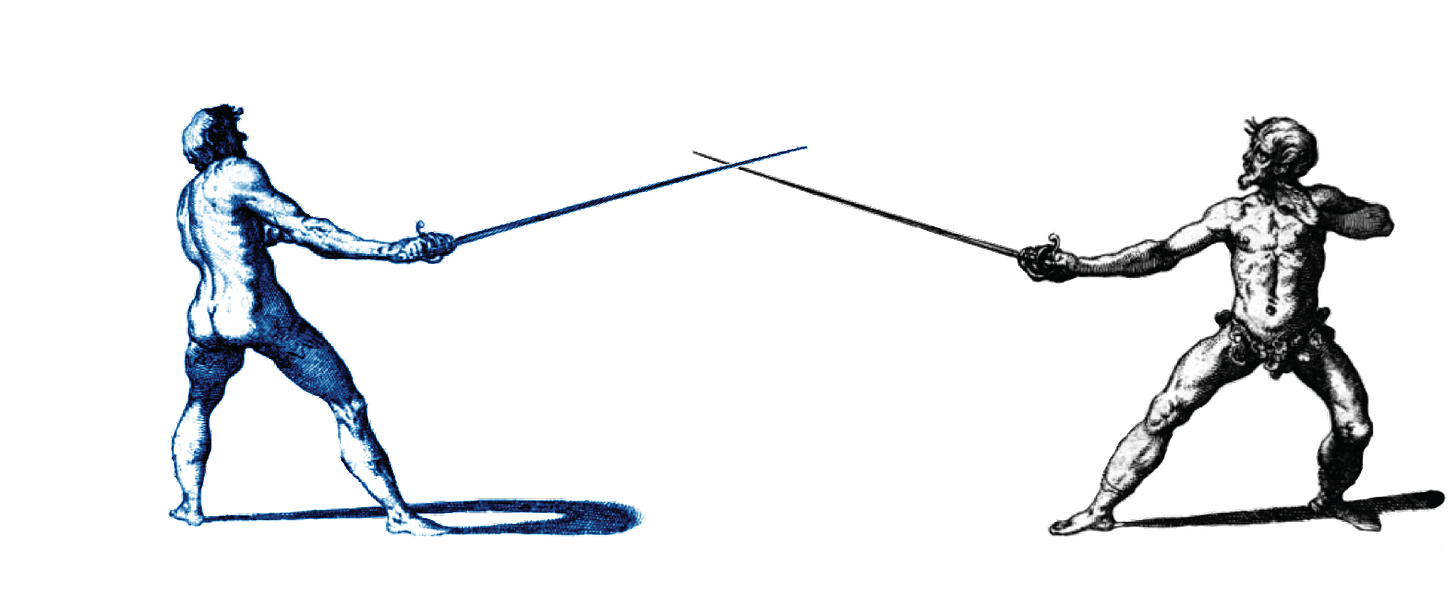Breaking down Capoferro’s plate 7
So now we are ready to look at the paired actions that come straight from Capoferro’s manual, starting with plate 7.1 Plate 7, and its partner, plate 16,2 really encompass most of what you need to know about Capoferro’s style, and possibly the Northern Italian system writ large, IF you know what you’re looking at. So accordingly, I tend to come back to this plate a few times as I teach, digging deeper and deeper into the tactics and decision trees depicted in this play. It has a lot to teach, but I unpack it over time. (NOTE: For reference, plate 7 from Capoferro is ostensibly the same action as plate 43 from Giganti. Capoferro’s plate 16 is Giganti’s plate 5.4)
***All of the quotes from Ridolfo Capoferro’s book in this issue are from the Swanger-Wilson translation.
So what’s happening In plate 7?
Player D constrains player C on the inside with a stringer.
C moves their sword to the other side and simultaneously attacks with a thrust to the chest - a forward-moving cavazione.
D turns their hand to seconda during C’s action, which gathers the debole of the incoming blade, and strikes C in the pie-hole or eye-hole.
Note that the text accompanying plate 7 consists of only two or three sentences (depending on whether you count the title of the plate as a sentence - I do). Similarly, plate 16 has only two or three as well. But far more things are happening than that coveys, as I’ll demonstrate more below and in future issues.
So we’re going to deconstruct these plays to get at the decisions being made and how those decisions, or tactics, become tools for you to play with in other actions.
Got that? So let’s start deconstructing!
Progressive Drills
The plays or plates of Capoferro and Giganti can be taught as a progressive drill, and that’s exactly what I do. The plays we will learn will be taught in three-part progressive drills.
For a quick overview of what that means, a progressive drill first teaches a thing - an attack, say. Then when you have that down pretty well, you add a counter to that attack, and you practice them together. Then, again, after you have those two steps down, you add a third step. Etc. It progressively builds the drill, an action, or a choice, at a time.
What you’re seeing in Capoferro’s and Giganti’s plates - and by that I mean the actual image printed in each manual - is essentially the final part of the three part progressive drill. It’s the end result of the decisions being made. But to understand it well, you have to go back and understand the parts that led up to the final action being shown.
First, it may be helpful to remember that the letter associated with each player tells you what posture they were in when the exchange “began.” When you look at the plates throughout Capoferro’s manual, the players have the letters A, B, C, D, E, or F associated with them, which all relate to prima, seconda, terza, quarta, quinta, and sesta.
In plate 7, D on the right started the action in some form of quarta. C was in a terza.
So, following are the three parts of the drill.
Part 1 - The Ideal Fight
The first action that makes up every play of Capoferro’s single sword is the ideal fight, which you learned in an earlier issue (here). You close, you stringer, your opponent does nothing, so you close more and/or transition into an offensive posture, gain the blade in the lunge and hit.
In this case, since the player on the right (D) started the action in quarta, my interpretation of the play is that D moved just into wide measure in terza and gained player C’s blade by a palmo. Player C didn’t react at that distance, so player D transitioned into an offensive quarta counterguard, which provoked the rest of the actions.
For drill one, then, player D moves into wide measure and gains player C’s blade in a terza counterguard. Player C doesn’t react. Player D transitions into quarta probably taking a small step as they do, and with almost no pause, dominates C’s sword and lands the hit. Again - review the episode on the ideal fight for a refresher if needed.
Part 2 - Cavazione
The counter to this ideal fight, that is also in virtually every plate in Capo Ferro and Giganti, is the cavazione (here). This is when you move your blade from one side of theirs to the other. It’s often called a disengage, but the problem there is that an engagement assumes your blades are in contact. And ours aren’t. So we’ll say a cavazione or ‘change of line.’
In the action of Plate 7, Player C doesn’t like that their blade has been constrained, and they see that D has left their shoulder and right side open, since D is pointing the sword across C’s body. So C quickly attacks while moving their sword under player D’s and to the other side. C gains D’s blade and strikes with domination.
Note that a cavazione - a change of side - is done while you’re moving forward, or moving back. In the case of this progressive drill, you are moving forward. Fabris describes it as a “spiralling in.” So you are not just changing sides, you are dropping your point below their blade, and as you bring the point back up you are moving forward, into a lunge.
I teach the cavazione as a modified “v” action. When someone’s sword is constraining mine, I would relax my hand a little to drop the point under my opponent’s blade - literally under their blade. Then the remaining action is tightening my hand again, bringing the point up on the other side of my opponent’s blade, but also immediately moving forward over their blade as I lunge to strike them.
Remember, extend the arm first and constrain their blade! I want to gain their blade advantageously with my forte, thus keeping myself protected, as I finish the cavazione and strike them.
So for this drill two:
Player D moves into wide measure and gains player C’s blade in a terza counterguard as before.
Player C doesn’t react.
Player D transitions into quarta, probably taking a small step as they do. Then…
NEW PART: …in the tempo of D’s transition and step, C performs the cavazione. As D is in motion, so is C. As D settles into quarta, their blade is being gained and dominated by C, who then runs them through.
This drill is about both the technique, and getting the tempo and measure correct. So it’s worthwhile to start this drill slowly, getting a handle on the actions themselves, then correcting for the measures, and then smoothing out the timing of all the actions to work on getting the tempi correct.
Part 3 - The End Game of Plate 7
So for drill three:
D enters measure, constrains C’s blade, and then steals a little more distance when C doesn’t react and transitioned into quarta, making C reassess their life choices.
But C sees D’s open shoulder as D moves in and they don’t like being constrained, so C launches a cavazione in the tempo of D’s transition. Then…
NEW PART: …here in progressive drill three, as C performs their cavazione D simply follows C’s blade with their hilt, rolling the hand from quarta (or the bastard guard) to seconda, re-gaining the blade and running C through.
This final drill is again about the technique, and getting the tempo and measure correct, but also the new technique adds changing your targeting in the middle of an action. So again, start slow, build the mechanics of the techniques, perfect the measures and then smooth the collected actions out to work on the tempi.
The steps of a complete plate 7 action
1. Player D (on the left) enters misura larga, stringering player C’s sword on the inside at about a palmo.
Player C doesn’t react yet.
2. Player D, safely constraining player C’s blade, closes and transitions into Quarta. This is where the action of the plate really begins.
3. Player C is further constrained, but sees an opening on the outside. The imagined path of the cavazione is marked in red.
4. Player C changes to the outside line while spiraling forward (cavazione).
Player D rotates the hand to second in the same tempo and re-gains player C’s sword, forcing it outside and winning the exchange.
The essence of plate 7
When you transition from terza into quarta and gain the opponent’s blade even more, you are providing a big provocation to react or die - the essence of the stringere. Your opponent reacts to your gain by moving their blade to your outside and is coming at you. Without altering your posture, you follow their cavazione, rolling your hand from quarta to seconda and hit them in the face while gathering their blade and re-closing the line.
Note that the opponent (C) is bringing the distance to you, so your job now is really to just concentrate on re-gaining their blade and extending over it a little. Your hilt should be guiding their point past you while you strike their head/neck area, as long as they’re aiming for the upper chest/head on you. You may need to bend your knee to finish the action, you may not. But a full extraordinary lunge is likely not needed here.
The moral of the story for plate 7
What the opponent is doing takes more time to do than your counter to it. And you have actively set them up for this. And this is part of the point - you created a situation where they have to take more time and movement to hit you than you do to defend it. AND you know that it’s coming, so you’re primed for it. This is one of the most physically efficient plays in Capoferro’s manual.
So…
Keep practicing closing distance and stringering. Keep working on the ideal fight. Make it smooth and work it up into being second nature. You close into wide measure, you stringer, you close a little more either by stepping or by shifting into an offensive posture (or both), and you “release” the lunge when your opponent does nothing in response.
Practice the cavatione by positioning the opponent’s blade over yours, then work on smoothly dropping your point and transitioning into a smooth constraining attack.
Then put it all together for the plate 7 end game - striking your target. Practice going from a quarta stringer to a seconda gain and attack.
The final counter
There is a fourth part of the progressive drill written into the text that accompanies the plate. It explains how C should have acted to keep from getting stabbed in the face. I’ll save these responses for their own post, though - it’ll be about what you can do when you’ve been gained.
Next up:
Interlude #1: A 16th century German saber (All subscribers)
Interlude #2 : An early 17th century three ring swept hilt rapier (All subscribers)
Ridolfo Capoferro. 1610. Gran Simulacro Dell’arte E Dell’uso Della Scherma. Translated by Jerek Swanger and William Wilson. Page 49.
Ibid. Page 67.
Giganti, Nicoletto. 1606. Scola, Overo Teatro. Page 23. Translated by Jeff Vansteenkiste.
Ibid. Page 25.










